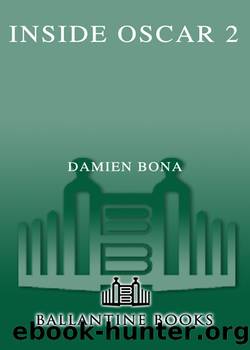Inside Oscar 2 by Damien Bona

Author:Damien Bona
Language: eng
Format: epub
ISBN: 9780345448002
Publisher: Random House Publishing Group
Published: 2002-02-06T00:00:00+00:00
* * *
Nature Boy
* * *
âSome films deal in plot truth; this one expresses emotional truth, the heartâs search for saving wisdom, in some of the most luscious imagery since Malickâs last film, the 1978 Days of Heaven,â declared Timeâs Richard Corliss. J. Hoberman wrote in the Village Voice: âThe yearâs most enigmatic studio release, written and directed by one of the most puzzling figures in Hollywood, The Thin Red Line projects a sense of wounded diffidence. Terrence Malickâs hugely ambitious, austerely hallucinated adaptation of James Jonesâs 1962 novelâa 500-page account of combat in Guadalcanalâis a metaphysical platoon movie in which battlefield confusion is melded with an Emersonian meditation on the nature of nature.â Hoberman concluded, âAs mystical as it is gritty, as despairing as it is detached, Malickâs study of men in battle materializes in our midst almost exactly a century after Stephen Craneâs The Red Badge of Courageâan exercise in nineteenth-century transcendentalism, weirdly serene in the face of horror.â The Christian Science Monitorâs David Sterritt felt that, âAlthough the story seems disjointed at times, no other war movie has tried so valiantly to convey not only the suffering of combat but the awful fissures it leaves between humanityâs ideal oneness with itself and the world we live in.â
The Thin Red Line had no stronger advocate than Godfrey Cheshire of the New York Press. He wrote, âOnce a year, if Iâm very lucky, a movie comes along that changes my life by doing that magical thing: sweeping me away on its torrent of images, ideas and feelings so decisively and thoroughly that I remain lost in its spell for days afterward, rapt and wonder-struck.â Cheshire said The Thin Red Line âis one of those inebriating films that draws its power from radically rediscovering the way we view the world through cinema.â As much as he adored the film, Cheshire seemed resigned that it was not for most moviegoers: âThe film recurrently dips into the memories and offhand musings of its many characters. It pauses to look at a branch, a leaf, a splash of light, a spray of clouds. This is something far beyond the superficial ârealismâ of most war movies, because it gives us something a filmâs plot canât touch: the momentary sensation of life lived in very close proximity to death.â Finally, Cheshire said, âIts burble of voices and perspectives invoke The Waste Land and Ulysses and their countless descendants. It is Mahler versus Spielbergâs Sousa, Rimbaud and Whitman (Leaves of Grass: great title for a Malick film) versus Disney rhymesters, the impressionists versus the worthy but limited lineage of N.C. Wyeth.â
Obviously, there would be plenty of reviewers who didnât appreciate what Malick was doing. Stuart Klawans of The Nation denigrated The Thin Red Line as âthe first New Age World War II movieâ and âmetaphysical guff.â Entertainment Weeklyâs Owen Gleiberman snorted, âThis is a war film made by a very somber flower child.â In his weekly column, Variety editor-in-chief Peter Bart kvetched, âPlotlines start and vaporize. Characters blend into one another.
Download
This site does not store any files on its server. We only index and link to content provided by other sites. Please contact the content providers to delete copyright contents if any and email us, we'll remove relevant links or contents immediately.
| Direction & Production | Reference |
The Kite Runner by Khaled Hosseini(5129)
Gerald's Game by Stephen King(4607)
Dialogue by Robert McKee(4352)
The Perils of Being Moderately Famous by Soha Ali Khan(4190)
The 101 Dalmatians by Dodie Smith(3480)
Story: Substance, Structure, Style and the Principles of Screenwriting by Robert McKee(3415)
The Pixar Touch by David A. Price(3389)
Confessions of a Video Vixen by Karrine Steffans(3271)
How Music Works by David Byrne(3232)
Harry Potter 4 - Harry Potter and The Goblet of Fire by J.K.Rowling(3030)
Fantastic Beasts: The Crimes of Grindelwald by J. K. Rowling(3028)
Slugfest by Reed Tucker(2969)
The Mental Game of Writing: How to Overcome Obstacles, Stay Creative and Productive, and Free Your Mind for Success by James Scott Bell(2873)
4 - Harry Potter and the Goblet of Fire by J.K. Rowling(2682)
Screenplay: The Foundations of Screenwriting by Syd Field(2598)
The Complete H. P. Lovecraft Reader by H.P. Lovecraft(2527)
Scandals of Classic Hollywood: Sex, Deviance, and Drama from the Golden Age of American Cinema by Anne Helen Petersen(2490)
Wildflower by Drew Barrymore(2465)
Robin by Dave Itzkoff(2410)
